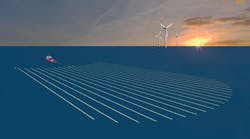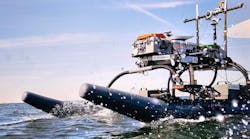Offshore staff
DUBLIN, Ireland – Providence Resources has issued an overview of results from the Ruadhan 3D seismic survey in the northern Porcupine basin offshore western Ireland.
The survey was over an area formerly known asSpanish Point South in frontier exploration license (FEL) 1/14. The location is in 500 m (1,640 ft) water depth, around 150 km (93 mi) from the coast.
Operator Capricorn’s initial assessment has demonstrated the presence of a significant north-south orientated Paleocene deepwater channelized system that covers at least 14 sq km (5.4 sq mi).
This feature had also been evident on the previous 2D seismic profiles. However, the new data have improved detailed imaging and suggest that the 1988 35/18-1 exploratory well operated by Amoco was drilled into a channel margin location (consistent with the post-drill interpretation).
That well encountered a 70-m (229-ft) interval of Paleocene deepwater sands which good porosities but low permeabilities, with gas shows. In addition, Amoco described a conventional core as bleeding “light tan oil.”
Capricorn’s interpretation indicates that the channel extends southward and down-dip out of the Ruadhan 3D survey area into the southern part of FEL 1/14 which is covered by 2D seismic.
The partners plan further assessment of the exploration potential of the channel and of Tertiary, Lower Cretaceous, and pre-Cretaceous objectives.
Providence’s technical director John O’Sullivan said: “These newly-acquired 3D seismic data allow for a significant uplift in our understanding of the previous 35/18-1 well supporting Amoco’s channel margin interpretation whilst also potentially pin-pointing the location of the channel axis reservoir sweet spot.
“Whilst these early observations are positive, further detailed seismic and well analyses are required in order to understand whether any potential resources associated with the main channel axis would merit the drilling of a new offset well.”
06/15/2015




